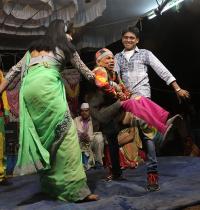Sandesh Bhandare
Grant Period: One year and six months
Sandesh Bhandare is a photographer based in Pune. Trained as a graphic designer, he has worked as a professional photographer for over three decades, with many solo and group exhibitions to his credit. This grant enables him to investigate into the changing practices and ecology of the performance form of Tamasha across Maharashtra.
The form of Tamasha is said to have emerged about 300 years ago as an entertainment for the Moghul and Peshwa armies. It was predominantly performed by the women of the lower caste Kolhati and Dauri communities, with a mix of seductive song, dance and satire woven into a simple narrative. However, over the years, the meaning and purpose of Tamasha changed, making it a vehicle for propaganda and an instrument of reform and social transformation. The themes came to include contemporary socio-political concerns.
In 2001, Sandesh received an IFA grant to photo document the Tamasha form and the lives of its performers. During this project, he travelled extensively with the Tamasha troupes in the Konkan, Vidarbha, Marathwada and western Maharashtra areas and extensively photographed their lives and practice. The work was subsequently published as a book in 2005, supported with another grant from IFA. The bilingual book is titled ‘Tamasha: Ek Rangadi Gammat’ in Marathi, and contains about 250 photographs accompanied by text that describes the different forms of Tamasha prevalent in Maharashtra. It is considered one of the most significant works on the Tamasha and is regarded highly in academic and performance circuits.
Now, fifteen years later, he feels the need to go back to these same places and revisit the practice and the practitioners. Many things have changed over the years, Sandesh says. Villages have become towns, blurring the divide between the urban and the rural; there has been extensive migration from the rural areas to the cities; the market economy has brought in privatisation, open door policies and globalisation; losses in agriculture have led to innumerable farmer suicides; and the role and meaning of entertainment has shifted. All these factors have had a huge impact on way the Tamasha is performed and viewed. Spaces for the Tamasha have shrunk drastically as the funding for it has plummeted. Several veteran Tamasha artists, including the Sangeet Natak Akademi awardees Kalu-Balu’s sons closed their Tamasha troupe recently owing to lack of funds. The performance duration itself has reduced from six to two hours, the publicity has become conservative and lack lustre and so on. The cumulative impact of socio-political and economic forces on the Tamasha form and the lives of its performers is something that Sandesh wishes to research into and document through his practice of photography.
However, despite these odds, the Tamasha is still a significant part of village fairs across Maharashtra. The troupes hold on to their performance spaces, however small it may be, and continue to regale their audiences. For instance, Sandesh says, in spite of the draught in Maharashtra this year, there were about 35 – 40 troupes that were invited to 50 – 60 villages to perform in local fairs commemorating the village god. Enabled with this grant, Sandesh will travel once again with the Tamasha troupes, mostly revisiting many of the places he had documented earlier. He plans to go back to villages in the Konkan, western Maharashtra, north Maharashtra, Vidarbha and Marathwada regions according to schedules of the Tamasha performances and availability of the artists at each particular place.
IFA’s decision for making this grant comes from our curiosity to understand the ways in which the practice of Tamasha and the lives of its performers have changed over the past fifteen years. Together with Sandesh’s earlier work, this project will be a significant contribution to understanding the endangered yet dynamic lives of particular art forms and their practitioners in an ever changing social milieu. A series of photographs with field notes by Sandesh will be the outcome of this project. Sandesh will also explore the possibility of this material being published as a book sometime in the future. The photographs and field notes will also be his deliverables to IFA.





